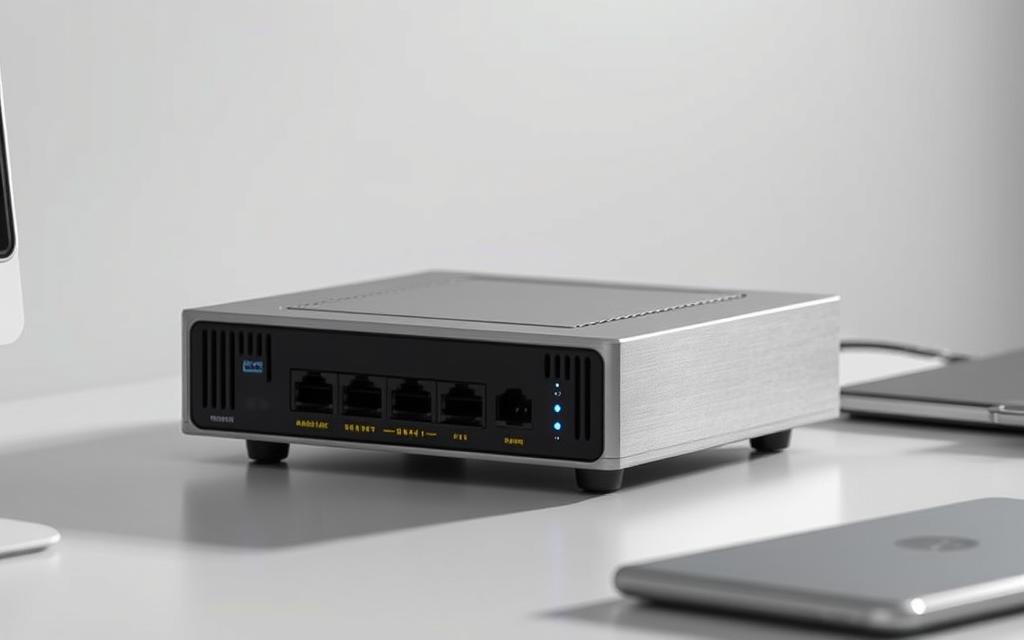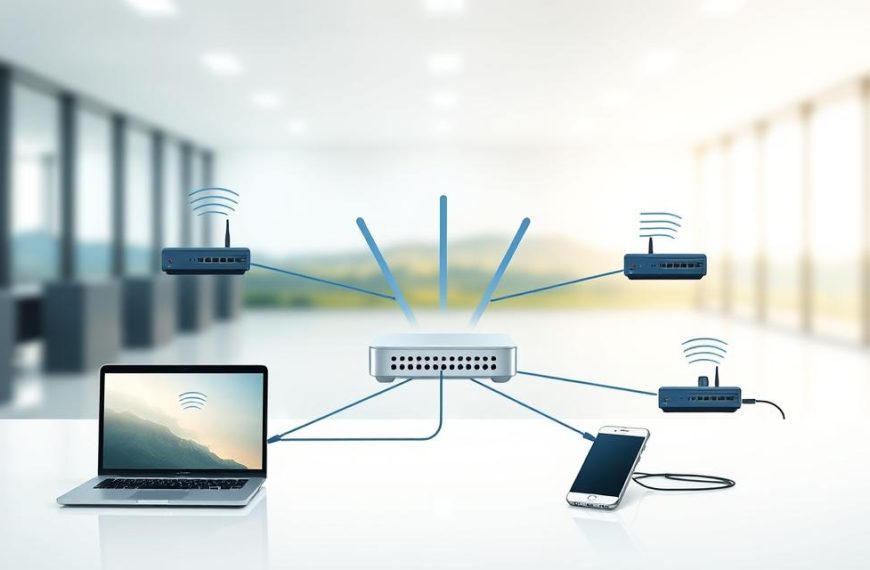A gateway is a vital network node that bridges networks using distinct transmission protocols. It functions as the essential point through which all data must flow or interact before being directed.
In modern computer networks, gateways serve as critical junction points, acting as translators and facilitators between different network environments. They enable communication between networks that use different protocols, architectures, or data formats, playing a fundamental role in facilitating seamless data flow across disparate systems.
Without gateways, our interconnected digital world would be fragmented into isolated network islands unable to share information or resources effectively, highlighting the importance of gateway security.
Understanding Network Gateways
The concept of a network gateway is fundamental to modern computer networks. A network gateway serves as a critical intermediary between different networks, enabling them to communicate effectively. This function is crucial in today’s interconnected world, where diverse systems and networks need to exchange data seamlessly.
What Is a Gateway in Computer Networks?
A gateway in computer networks is a device or software that connects different networks, allowing them to communicate with each other. It performs protocol conversion, enabling networks that use different protocols to exchange data. This capability is essential for integrating diverse systems and ensuring that data can be transmitted across different network environments. Network gateways are vital for facilitating communication between networks that have different architectures, protocols, or technologies.
The Evolution of Network Gateways
The evolution of network gateways has been significant, driven by the increasing complexity of networks and the need for secure, reliable interconnections. Initially, gateways were simple protocol converters. However, they have evolved into sophisticated multi-function devices that combine routing, security, and application-level services. Modern gateways incorporate advanced features such as deep packet inspection, application awareness, and cloud integration. The flexibility of gateways has led to the development of various gateway types, each tailored to specific user requirements.
Key developments in the evolution of network gateways include:
- The incorporation of firewall capabilities and intrusion detection systems to address emerging security challenges.
- The integration of advanced features like deep packet inspection and application awareness.
- The development of various gateway types to meet specific user needs.
- The enhancement of gateways to support cloud integration and diverse network protocols.
Today’s network gateways represent the culmination of decades of networking innovation, offering unprecedented flexibility and functionality for connecting disparate network environments.
How Gateways Work in Computer Networks
The functioning of gateways is pivotal in enabling disparate networks to interconnect seamlessly. Gateways are complex devices that perform a multitude of tasks to ensure efficient data transfer between different networks.
Basic Gateway Architecture
Gateways are equipped with sophisticated architecture that enables them to process and route data packets effectively. The basic components of a gateway include a processor, memory, and network interfaces. These components work in tandem to facilitate data packet processing and routing.
Modern gateways employ advanced techniques such as quality of service (QoS) management to prioritise certain types of network traffic, ensuring that critical applications receive adequate bandwidth and minimal latency.
Data Packet Processing and Routing
When a data packet reaches a gateway, it undergoes a series of sophisticated operations. The gateway first examines the packet header to determine its destination and verify its integrity. This process involves:
- Header analysis to determine the packet’s destination and verify its integrity.
- Protocol conversion to transform the data format and addressing scheme to match the requirements of the destination network.
- Address translation to ensure seamless communication between different networks.
- Routing decisions based on comprehensive routing tables to identify the optimal path for data packets.
By performing these operations, gateways enable efficient data transfer between different networks, ensuring that data packets reach their intended destinations.
What is the Role of Gateway in Computer Network
In computer networks, gateways are essential for enabling data exchange between heterogeneous systems. A gateway in networking is also a part of any telephony system, providing a bridge between the phone network and the Internet. For instance, setting up a direct call for a customer involves several tasks, including automatically detecting the customer’s current location and converting audio back and forth between different technologies.
Primary Functions of Network Gateways
Network gateways perform several primary functions that are crucial for maintaining efficient and secure network operations. These functions include protocol translation, data conversion, and security enforcement. Gateways enable heterogeneous networks to function as a cohesive system despite fundamental differences in their underlying technologies. They facilitate communication between different networks, allowing for the seamless exchange of data.
- Protocol translation: Gateways translate protocols to enable communication between networks using different protocols.
- Data conversion: They convert data formats to ensure compatibility between different systems.
- Security enforcement: Gateways enforce security policies across different networks, providing a centralised point for security management.
Why Gateways Are Essential for Network Communication
Gateways are vital for modern network communication because they enable the integration of legacy systems with modern network infrastructure. This integration preserves investments in existing technology while allowing for modernisation. The security functions of gateways are increasingly critical as networks face sophisticated threats. As networks grow more complex with cloud services, IoT deployments, and multi-vendor environments, gateways become even more essential for maintaining seamless communication across these diverse network domains.
| Function | Description | Benefit |
|---|---|---|
| Protocol Translation | Translates protocols for compatibility | Enables communication between different networks |
| Data Conversion | Converts data formats for compatibility | Ensures seamless data exchange |
| Security Enforcement | Enforces security policies across networks | Provides centralised security management |
As emphasised by a leading networking expert, “Gateways are the backbone of modern network infrastructure, enabling secure and efficient communication across diverse network environments.” This underscores the critical role gateways play in facilitating network communication.
Types of Network Gateways
The versatility of network gateways is evident in their various types, each designed for particular network requirements. Network gateways are crucial for facilitating communication between different networks, and their types vary based on the specific needs they address.
Protocol Gateways
Protocol gateways are designed to facilitate communication between networks that use different protocols. They translate protocols, enabling devices with incompatible protocols to exchange data seamlessly. This type of gateway is essential in heterogeneous network environments where multiple protocols coexist.
Internet Gateways
Internet gateways connect private networks to the internet, providing a pathway for data to flow between the two. They often include Network Address Translation (NAT) capabilities, allowing multiple devices on a private network to share a single public IP address when accessing the internet.
Application Gateways
Application gateways operate at the application layer of the OSI model, providing a high level of control over the data being transmitted. They can inspect and filter traffic based on application-specific rules, enhancing security and performance. These gateways are particularly useful for managing traffic related to specific applications.
Security Gateways
Security gateways are specialized gateways that focus on protecting network boundaries by implementing comprehensive security policies. They combine various security functions, including firewall capabilities, intrusion detection and prevention, and content filtering, into a unified platform. Modern security gateways employ advanced techniques such as deep packet inspection and threat intelligence integration to safeguard against emerging threats.
These gateways are crucial for organizations with complex network infrastructures, providing granular control over data flow and ensuring consistent protection across distributed network environments.
Specialised Gateway Applications
Modern network architectures rely on specialised gateway applications to enable seamless communication across different systems. These gateways are designed to address specific industry requirements, enhancing the functionality and efficiency of network services.
IoT Gateways
IoT gateways serve as a critical component in Internet of Things (IoT) ecosystems, facilitating communication between IoT devices and the cloud or other networks. They provide data processing and security features, ensuring that IoT devices can operate efficiently and securely. IoT gateways often support multiple protocols, enabling interoperability between diverse IoT devices.
Cloud Storage Gateways
Cloud storage gateways act as an intermediary between on-premises storage infrastructure and cloud storage services, providing a unified storage management layer. They enable organisations to integrate cloud storage with their existing storage systems, offering benefits such as data tiering, backup, and disaster recovery. Cloud storage gateways can also provide data optimisation techniques like deduplication and compression.
Payment and Media Gateways
Payment gateways and media gateways are specialised applications that cater to specific industries. Payment gateways securely process payment information between customers, merchants, and financial institutions, implementing robust security measures like encryption and fraud detection. Media gateways, on the other hand, enable interoperability between different communication systems, converting media streams between various formats and protocols used in telecommunications. For instance, media gateways bridge traditional telephony systems with IP-based communications in Voice over IP (VoIP) deployments.
These specialised gateway applications highlight the versatility and importance of gateways in modern network infrastructure, enabling efficient and secure communication across diverse systems and industries.
Gateway vs. Other Network Devices
Understanding the differences between a gateway and other network devices is crucial for designing efficient network architectures. While various devices play distinct roles, their functions often overlap, leading to confusion.
Gateway vs. Router: Key Differences
A gateway and a router are both critical components of a network, but they serve different purposes. A router connects multiple networks together and routes traffic between them, whereas a gateway acts as a bridge between different networks, enabling communication through protocol translation.
- A router operates at layer 3 of the OSI model, focusing on routing data packets.
- A gateway, on the other hand, can operate at multiple layers, including layer 7, facilitating complex protocol conversions.
Gateway vs. Switch and Bridge
Switches and bridges are network devices that operate at layer 2 of the OSI model, primarily facilitating data transfer within a single network. Unlike gateways, they do not perform protocol translation or connect different networks.
- Switches connect multiple devices within a network, improving network efficiency.
- Bridges connect two separate networks, but they operate at a lower layer and do not perform the complex protocol conversions that gateways do.
Gateway vs. Firewall and Proxy
Security is a critical aspect of network management, and devices like firewalls and proxies play key roles. Firewalls filter traffic based on security rules, while proxies act as intermediaries for client-server communications.
- Firewalls specialise in security enforcement, whereas gateways focus on enabling communication between different networks.
- Proxies operate within the same protocol framework, whereas gateways translate between different protocols.
In summary, while various network devices work together to ensure efficient and secure network operation, their roles are distinct. Gateways enable communication between different networks, routers route traffic, switches and bridges facilitate data transfer within or between networks, and firewalls and proxies enhance security and optimise traffic.
Protocol Translation and Data Conversion
In computer networks, gateways perform the critical task of translating data between different protocols, enabling disparate networks to communicate effectively. This function is vital for ensuring that data can be exchanged between networks that use different protocols.
Handling Different Network Protocols
Gateways are designed to handle various network protocols, including IPv4 and IPv6. They can translate between these protocols, allowing devices on different networks to communicate. Protocol translation involves converting data from one protocol to another, ensuring that the information remains intact.
The Translation Process
The translation process in network gateways involves several steps: receiving data in the source protocol, parsing and interpreting the data structure, mapping to equivalent functions in the destination protocol, and reconstructing the data in the new format. This complex process requires state management to ensure proper translation of stateful protocols.
- Address translation is a critical component, mapping between different addressing schemes.
- Data format conversion involves transforming between different encoding schemes or data structures.
- The complexity of the translation process varies depending on the protocols involved.
Security Functions of Network Gateways
Network gateways are pivotal in maintaining network security by defending against cyber threats and vulnerabilities. They serve as a critical layer of defense, preserving a network’s integrity, confidentiality, and availability.
Gateway Security Features
Gateways incorporate various security features to protect networks. They can support virtual private networks (VPNs), ensuring secure remote access for employees while maintaining data encryption and confidentiality. Gateway security features are designed to defend against a wide array of cyber threats and vulnerabilities.
Some key security features include intrusion detection and prevention systems, malware scanning, and content filtering. These features help to identify and block malicious activity, thereby protecting the network from potential security breaches.
Implementing Gateway Security Best Practices
Implementing gateway security best practices is crucial for maintaining network security. This begins with proper network segmentation, using gateways to create security zones with different levels of protection based on the sensitivity of the resources they contain.
- Regular updates and patches for gateway firmware and software are essential to address known vulnerabilities and ensure protection against emerging threats.
- Strong authentication mechanisms should be implemented for gateway access, including multi-factor authentication for administrative interfaces and secure credential management.
- Comprehensive logging and monitoring of gateway activity provides visibility into network traffic patterns and potential security incidents, enabling rapid response to suspicious activities.
- Defence-in-depth strategies should be employed, with gateways forming one layer of a comprehensive security architecture that includes endpoint protection, network monitoring, and security awareness training.
Traffic Management and Routing Capabilities
Traffic management and routing capabilities are crucial functions of contemporary network gateways. These capabilities ensure that network traffic is managed efficiently, maintaining optimal network performance.
Load Balancing and Traffic Prioritisation
Modern gateways implement load balancing and traffic prioritisation to distribute network traffic across multiple paths, preventing any single path from becoming overwhelmed. This ensures that critical applications receive the necessary network resources. Load balancing techniques include:
- Distributing incoming traffic across multiple servers
- Dynamic routing adjustments based on network conditions
- Session persistence to maintain user sessions
Quality of Service Implementation
Quality of Service (QoS) implementation in network gateways involves classifying traffic into different service classes based on application requirements or business priorities. Gateways enforce QoS policies through mechanisms such as traffic marking, queue management, and bandwidth allocation. Common QoS frameworks include Differentiated Services (DiffServ) and Integrated Services (IntServ).
| QoS Framework | Description | Benefits |
|---|---|---|
| Differentiated Services (DiffServ) | Classifies traffic into different service levels | Scalable, flexible service differentiation |
| Integrated Services (IntServ) | Provides guaranteed service levels for specific applications | Guaranteed bandwidth, controlled latency |
Effective QoS implementation ensures that real-time applications, such as voice and video conferencing, receive the necessary network resources to maintain quality.
Gateway Implementation Considerations
To achieve optimal network functionality, it’s essential to carefully plan gateway implementation. Effective gateway deployment requires a comprehensive understanding of both the network requirements and the capabilities of the gateway technology.
Selecting the Right Gateway Type
Choosing the appropriate gateway type is critical for meeting the specific needs of an organization’s network. This involves analyzing factors such as the type of data being transmitted, the protocols used, and the security requirements. Protocol gateways, internet gateways, and application gateways each serve distinct purposes and are suited to different network configurations.
Performance and Redundancy Planning
Performance planning for gateway implementations involves thorough analysis of traffic patterns, including peak volumes and typical packet sizes. Ensuring adequate capacity is crucial to prevent bottlenecks. Redundancy planning is also vital, particularly in business-critical environments, where a single point of failure could have significant consequences. Techniques such as active/passive pairs and load balancing can enhance network reliability.
- Analyzing maximum concurrent connections and required throughput.
- Assessing packet processing capabilities and latency sensitivity.
- Implementing redundancy to prevent single points of failure.
- Benchmarking gateway performance with security features enabled.
By carefully considering these factors, organizations can ensure their gateway implementation meets current and future network demands, maintaining optimal performance and reliability.
Limitations and Challenges of Network Gateways
As a critical component of network infrastructure, gateways face several operational challenges that can impact their performance and overall effectiveness. Network gateways are designed to facilitate communication between different networks, but they are not without their limitations.
Performance Bottlenecks
One of the primary challenges associated with network gateways is the potential for performance bottlenecks. As network traffic increases, gateways can become overwhelmed, leading to delays and decreased network efficiency. This can be particularly problematic in environments with high-bandwidth requirements or where multiple networks are connected through a single gateway.
Configuration Complexity
The configuration complexity of network gateways presents significant challenges, particularly in environments with diverse protocols and complex routing needs. Gateway configurations often require specialised expertise across multiple domains, including networking, security, and specific application protocols. Changes to gateway configurations carry substantial risk, as misconfiguration can disrupt all traffic flowing between networks or create security vulnerabilities.
- Gateway configurations require specialised expertise, making them difficult for general IT staff to manage effectively.
- Troubleshooting gateway issues is complicated by their position between different networks.
Conclusion
In the vast digital landscape, gateways serve as the crucial link that enables seamless information exchange between disparate networks.
The multifaceted role of gateways encompasses protocol translation, security enforcement, traffic management, and application optimisation, making them critical components of modern network architectures.
As networks continue to evolve with cloud services, IoT devices, and increasingly diverse communication requirements, the importance of gateways as integration points between these environments will only grow, facilitating reliable and secure communication across technological boundaries.
- Network gateways enable communication between disparate networks, fostering a more interconnected world.
- The future of network gateways will likely see further integration of advanced capabilities, including artificial intelligence for security and performance optimisation.
Understanding the fundamental functions and capabilities of gateways is essential for network professionals seeking to design resilient, secure, and high-performance network infrastructures in today’s complex digital landscape.
















